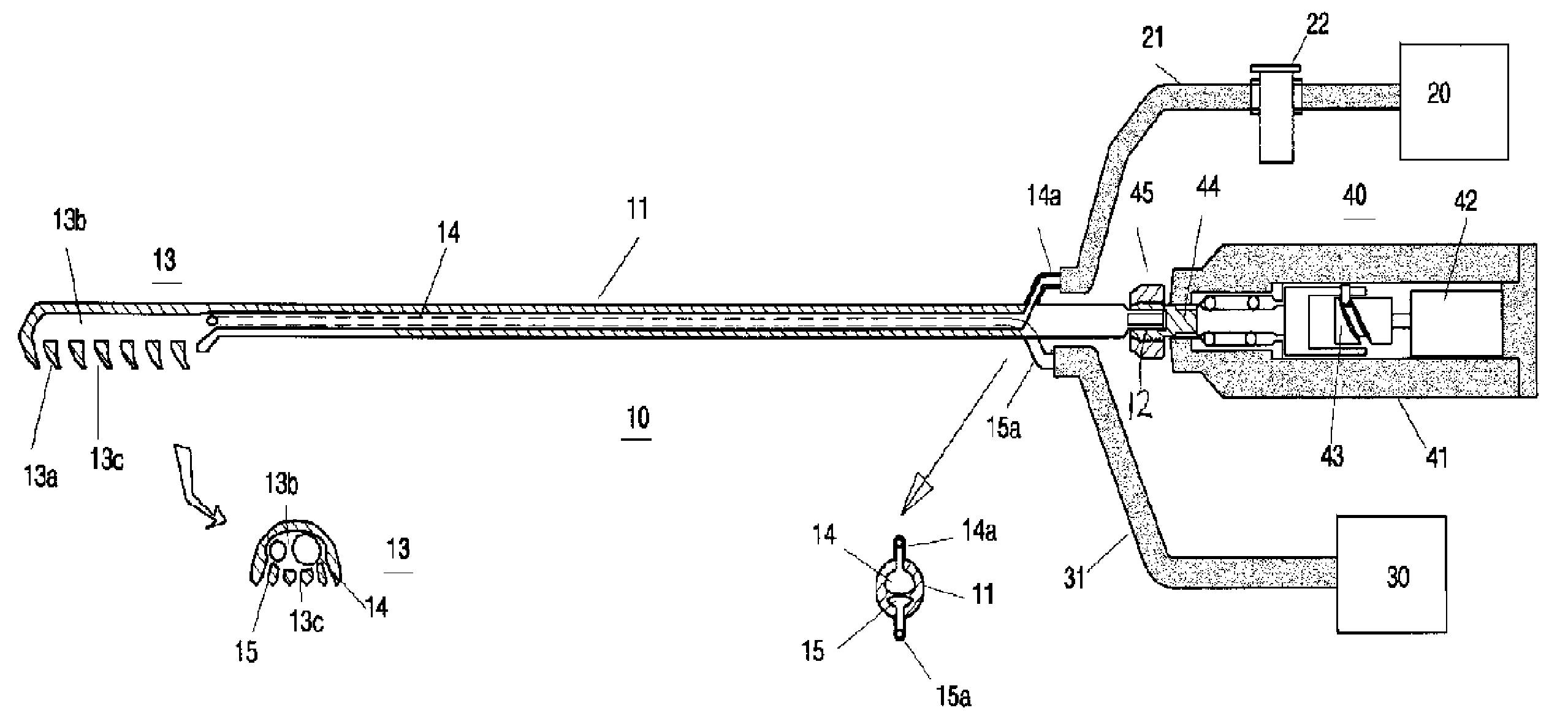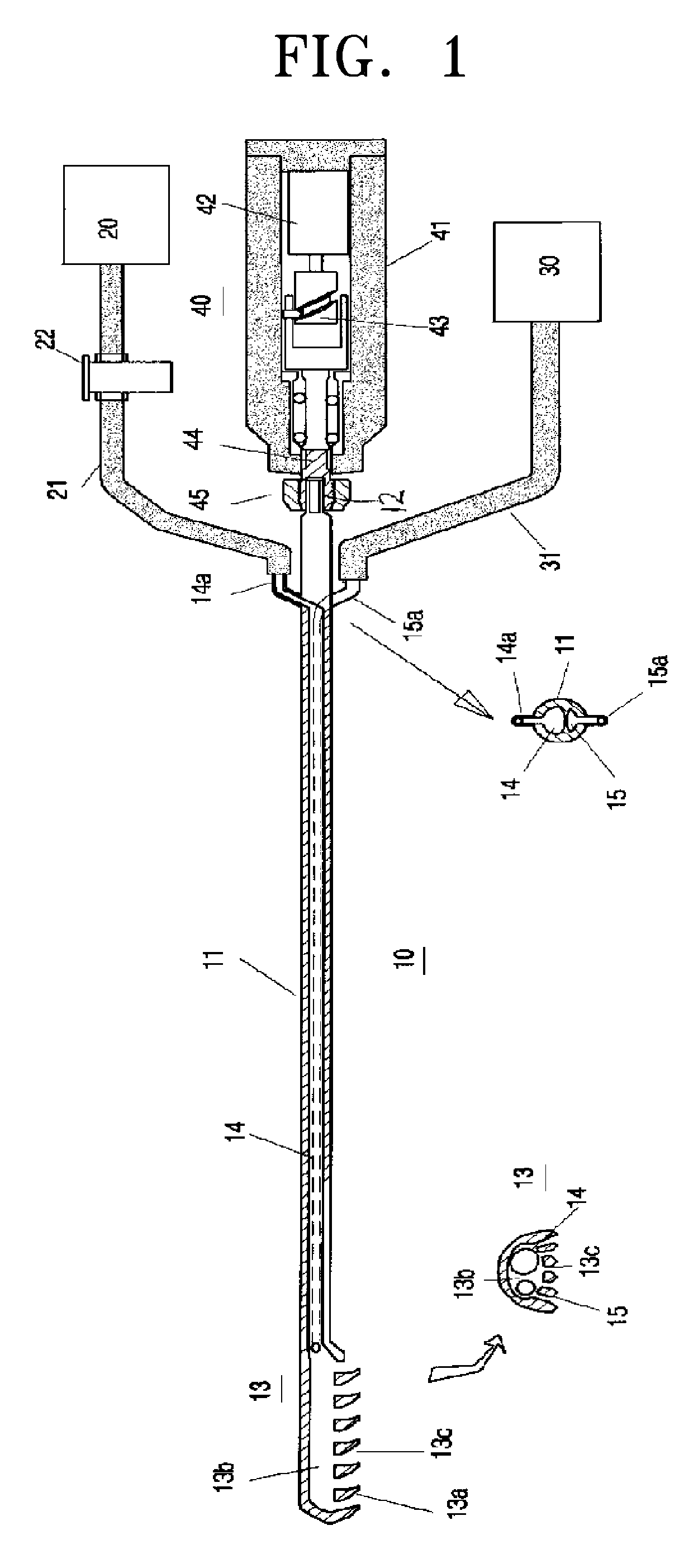Since a large quantity of bone is cut using such a saw at once, the accuracy in bone cutting is difficult to achieve.
Accordingly, the conventional method has several problems such as severe swelling and
excessive bleeding of the cutting site,
delayed healing, cutting of vessels, nerve damage, etc.
Further, the saw for cutting bone may cause severe injuries to
peripheral soft tissues around the incision during the movement.
However, since there is not yet developed any device to meet this requirement, it is difficult to stably perform surgery using the rasp.
Since bone fragments are accumulated, aggregated and compressed between blades of the conventional rasp during the operation, continuous cutting using the rasp is impossible.
Thus, since blades of electric-powered or pneumatic rasps must be cleaned off every several seconds, it is impossible to
grind a large amount of bone using these rasps in the facial bone contouring surgery.
Further, the stacking of the bone fragments on the blades is made more severe by heat generated from the cutting plane of the electric-powered or pneumatic rasps.
On the other hand, hand-powered rasps do not generate heat but have a low operational speed, thus being impractical to use.
The conventional electric-powered or pneumatic devices cannot be inserted under the
skin via a
small incision so as to continuously
grind a large amount of bone.
These conventional devices have limitedly been used to remove a small amount of bone.
However, these devices have a structure which cannot be used in facial bone contouring surgery.
However, the conventional devices do not meet these requirements, thus not being used in facial bone contouring surgery.
However, this
assembly cannot supply a saline solution to the cutting surface, thus not eliminating heat generated on the cutting surface when a large quantity of bone such as
zygomatic bone, maxilla or mandible is continuously removed.
Further, the inlet has a structure such that the continuous cutting of bone cannot be performed and bone debris aggregated and compressed between blades of the rasp cannot be exhausted to the outside, thus requiring frequent cleaning.
Accordingly, this
assembly can be used in surgical facial procedures such as rhinoplasty and supraorbital procedures, but cannot be effectively used in the skin overlying the area of the supraorbital bone that is to be reshaped or contoured.
Here, heat is generated due to friction between the rasp and the bone, thus causing damages such as burning of soft tissues or deformation of tissues.
Further, the cut fragments of bone are aggregated during cutting and accumulated between blades of the rasp, thus not being exhausted to the outside and remarkably reducing the cutting efficiency of the
assembly.
Since the collected bone fragments are damaged by the heat generated due to friction between the rasp and the bone, it is difficult to use the damaged bone fragments in
bone tissue culture.
Further, during the driving of the cutting member, the cutting member irritates and damages
peripheral soft tissues around the operative site.
Further, the assembly does not have a
double tube structure, thus not protecting
peripheral regions around the operative site during the
insertion and operation of the rasp, and causing inconvenience to a surgeon in case that the rasp is inserted into the operative site via a small and deep incision.
Since the friction generated between the cutting plane of the rasp operated at a high speed and the bone damages peripheral tissues, this assembly is not suitable for use in facial bone contouring surgery.
However, since heat generated on this cutting means cannot be eliminated and bone
crash is accumulated between blades of the cutter, the cutting means is not suitable for use in removal of a large quantity of bone or for facial bone contouring surgery.
However, an inlet does not pass through the cutting plane, thus generating many bone fragments and causing a difficulty in sucking large-sized tissue fragments.
That is, the slits between the blades of the rasp are easily clogged with the cut bone fragments.
Although the saline solution is sprayed via the through-holes, since the spraying pressure of the saline solution is smaller than the suction pressure of the bone fragments, the through-holes are easily clogged with the bone fragments.
However, the above structure does not meet this requirement.
Further, with the above structure, it is impossible to form the maximum cutting plane via the minimum outer
diameter of the cutter.
This hand-powered rasp sucks only air via the openings, but does not feed saline solution for removing generated heat and remove bone fragments at a high speed.
Further, the rasp does not have a double cannula structure, and the size of the openings is not sufficient to suck the cut bone fragments together with air.
Moreover, it is difficult to manufacture a cutter of the rasp being suitable for use in facial bone contouring surgery.
However, the hand-powered vacuum rasp having this suction structure cannot be used in facial bone contouring surgery.
However, these instruments perform the tissue cutting using a rotary blade, thus causing exposed portions of nerves and vessels in facial bone contouring surgery to be dangerously rolled into the blade.
Further, these instruments remove only portions sucked into protrusions or an external
pipe, thus not being used in reduction of a broad area such as facial bone contouring surgery.
 Login to View More
Login to View More  Login to View More
Login to View More 


